
by bungalow101 | Jun 25, 2022 | Features
by Jane Powell, author & Linda Svendsen, photographer
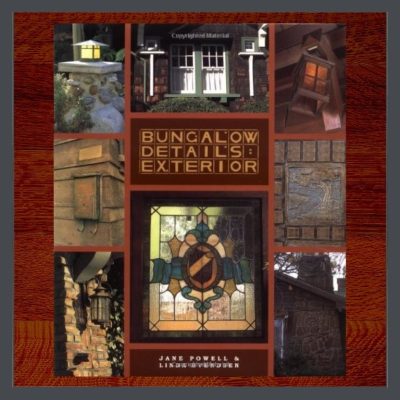 For BUNGALOW DETAILS: EXTERIOR, as with DETAILS: INTERIOR, I’m going to go chapter by chapter highlighting the contents of this wonderful & informative book, while pointing out the pages that have pictures of my house!
For BUNGALOW DETAILS: EXTERIOR, as with DETAILS: INTERIOR, I’m going to go chapter by chapter highlighting the contents of this wonderful & informative book, while pointing out the pages that have pictures of my house!
The very first image in the book, is a full-pager of a river rock column topped by a lantern. Though unidentified in the book, this column was crafted by the steward of the Hanson Puthuff House in Eagle Rock, California. (As defined by the U.S. Department of Agriculture, “Archaeological stewardship is the preservation, protection and maintenance of cultural resources. This involves making sure that cultural resources are not looted, vandalized or destroyed. Stewards are both caretakers and advocates of the archaeological record.”)
Hanson Puthuff was the father of the plein air movement (which just means painting outside) in California. The current owners of his home, both artists themselves, meticulously preserved, protected & maintained this valuable cultural resource, researched its astonishing & varied history (It spent some time as a sweatshop where indentured workers toiled for hours all day & then slept at night, in the crawlspace, under the house.) & submitted it for inclusion as a Los Angeles Historic Landmark. Not surprisingly, it was accepted.
Allow me to take this moment to suggest that you take advantage of our BUNGALOW DETAILS: EXTERIOR, GLOSSARY should you run into any terms that you might not understand. It will enhance your education & your enjoyment of the article.
FOREWARD OF BUNGALOW EXTERIOR: DETAILS
Jane was a dear friend (Read about our story here.) & spoke often of her father & this book is dedicated to him because he taught her that details matter. I think so too.
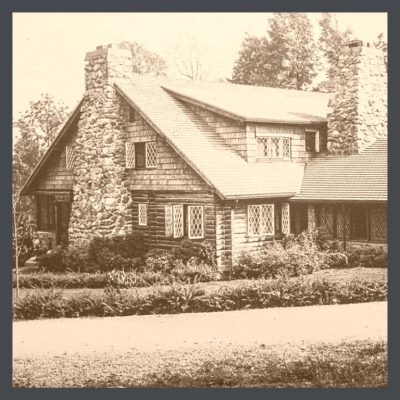 CHAPTER ONE: WHAT IS A BUNGALOW
CHAPTER ONE: WHAT IS A BUNGALOW
In this section Jane gives us a brief history of the bungalow & what she terms “The Reader’s Digest of the Arts & Crafts Movement.” The first illustration is the quintessential American A & C house, Gustav Stickley’s house at Craftsman Farms in Parsippany, New Jersey, followed by vintage ads for bungalow plans & then more of Linda’s photos of houses with unique features.
CHAPTER TWO: GOOD HOUSE KEEPING
In this chapter, Jane stands with one hand on her hip, shaking her figure, admonishing us to maintain our houses or buy a condo. In it she includes Erik’s Bungalow Manifesto, of course, with comments.
CHAPTER THREE: TAKE IT FROM THE TOP
If you want to know about every type of bungalow roof made, you can learn it here, with illustrations. She also covers materials such as tile, slate & asphalt. My favorite is one that is composed of over-lapping metal barrel lids. We get to see a variety of chimneys (including mine on page 57) & gutters. We see dormers & brackets in all configurations. She includes an image of pre-fab rafter tails that are very cool & I’m think of houses on which I have seen with such tails.Jane lists 2 full pages of resources for roofing materials of all types, chimney parts, gutters & anti-pigeon devices. She’s really not a fan of pigeons & is often eloquent in stating her low opinion of them.Throughout the chapter she again offers restoration solutions, both obsessive & compromising.
CHAPTER FOUR: THE ENVELOPE PLEASE
It’s all about the walls- logs, shingles, brick of all types, colors & textures, wood siding, board & batten, beadboard, half-timbering, molded concrete, hollow tile, stucco- the good.
Asphalt, aluminum, vinyl-not so much. A key point she brings up here is the fact that vermin love that “maintenance-free” siding. It’s hidden. It’s dark. It’s damp. It remains undisturbed for decades.
She shows us some creative gable ends, with unique attic vents, rafter tails & other ornamentation.
At the end of the chapter- more resources for materials.
CHAPTER FIVE: GRAND OPENINGS
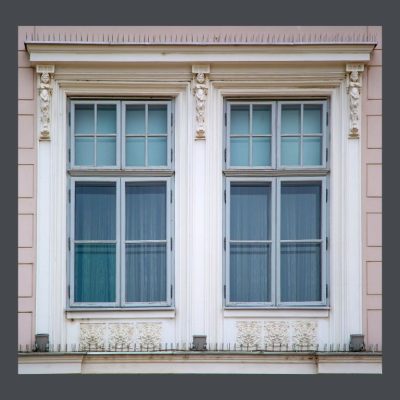 Jane loves windows, referring to them as the most important part of the bungalow. She gives us a brief history of window & glass development, with plenty of illustrations in both Linda’s photos & manufacturer pictures. These images also show different muntin (the strip of wood separating & holding panes of glass in a window) configurations.
Jane loves windows, referring to them as the most important part of the bungalow. She gives us a brief history of window & glass development, with plenty of illustrations in both Linda’s photos & manufacturer pictures. These images also show different muntin (the strip of wood separating & holding panes of glass in a window) configurations.
Jane enumerates the “obfuscations” used by window manufacturers to confuse people in making clear judgements regarding window replacement. It’s worth reading the list & if you are considering yanking your windows, I’d so go far as to call it mandatory.
She teaches us how to make a storm window & then talks about screens. I highly recommend having screens on your windows so your cats (Jane loved cats.) can smell the outdoors. I also recommend that your windows are in good repair, with some sort of stop, so that you don’t experience a sash come crashing down on an innocent kitty.
Then on to doors where she provides us with some beautiful images. Many styles were appropriate & she thoughtfully has 2 pages of historic manufacturer images giving us a grand array.
If you want to know more about windows, you could read what I have to say about them here!
Her resources list closes the chapter. (Get it? Like you close a door? Are puns contagious?)
CHAPTER SIX: THE FOUNDATION OF KNOWLEDGE
This is a short chapter ‘splaining how a foundation is built. It’s a good thing to know because your bungalow has one.
CHAPTER SEVEN: LET’S PORCH THE PLACE
“…It is impossible to live upon own’s lawn in privacy. The veranda offers a compromise between indoors & outdoors, and had developed into a species of open-air room, the furnishings of which is quite as important as that of any other room in the house.”- Esther Singleton in American Homes and Gardens, May 1907
This is a nice, long chapter featuring images of many porches in a multitude of styles. While Jane’s favorite feature is windows, mine is porches. I love the opportunities for the variety of columns, double, triple, elephantine in an abundance of materials.
Although doors were in the previous chapter, she covers door hardware, another one of my most appreciated porch features. Hardware is well represented in this book with several pages of historic manufacturer images!
And once again, Jane did her homework with a nice list of resources.
CHAPTER EIGHT: OUTSIDE CHANCES
The history of garages is interesting. People used to put their cars in the carriage house with the carriage & the horse. Poor horses!
We learn here about porte cocheres, about the many styles of garages, & about garage apartments.
 On page 190 is my very most favorite image of my house. See the little old lady standing under the arbor with her walker? It’s the ghost of my dear mother. A couple days before the shoot, someone had decided to “trim” the honeysuckle growing on my willow arbor. I was devastated.
On page 190 is my very most favorite image of my house. See the little old lady standing under the arbor with her walker? It’s the ghost of my dear mother. A couple days before the shoot, someone had decided to “trim” the honeysuckle growing on my willow arbor. I was devastated.
My 80-year-old mother had arrived for a visit from Northern California & gasped when she saw the massacred vines. Without even going in the house, she asked for plant ties & clippers. She stood outside, under the arbor, propped up by her walker, coaxing the tendrils up, up, up so that they finally covered most of it. She’s gone now, but the image of her there, standing determined, has never left my heart.
And more resources.
CHAPTER NINE: FINAL CONFUSION
Jane gives the last word in BUNGALOW DETAILS: Exterior, to Ernest Freese whose merry bit of prose, A Bungle Ode, was published in The Architect and Engineer of California in 1918. A nonsensical composition, poking fun at all things bungalow, Jane explains that including it doesn’t mean that she’s not serious about bungalows.
It just means that Jane is not serious.
READ ALL JANE’S BOOKS ABOUT BUNGALOWS!
 BUNGALOW KITCHENS
BUNGALOW KITCHENS
Restoring the heart of the home.
 BUNGALOW BATHROOMS
BUNGALOW BATHROOMS
Everything you need to know to restore or create a beautiful & functional bungalow bathroom.
 BUNGALOW DETAILS: INTERIOR
BUNGALOW DETAILS: INTERIOR
Your inspiration for a beautiful home.
 BUNGALOW: THE ULTIMATE ARTS & CRAFTS HOME
BUNGALOW: THE ULTIMATE ARTS & CRAFTS HOME
All things bungalow.
& last but not least
 LINOLEUM
LINOLEUM
It’s not vinyl!
Connect STAY IN THE BUNGALOW KNOW!!!
STAY IN THE BUNGALOW KNOW!!!
Sign up for our newsletter & receive our FREE E-book, 7 VITAL Things to Do Before You Hire a Contractor.
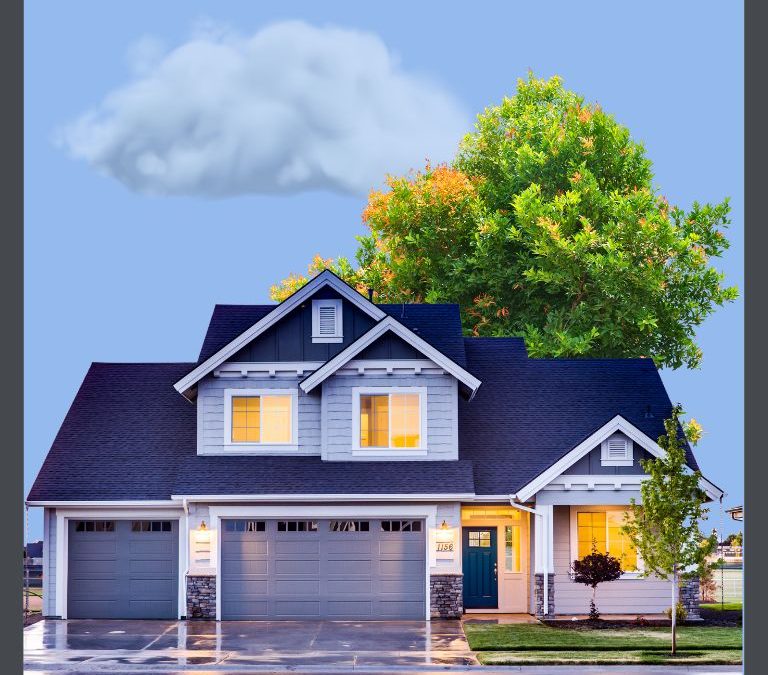
by bungalow101 | Jun 19, 2022 | Noted architects
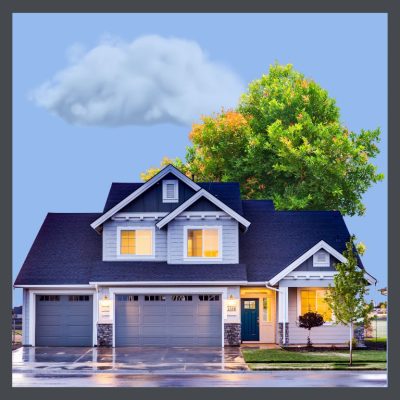 Most people don’t know about preservation architects & how the hiring of one can save you headaches, time & money.
Most people don’t know about preservation architects & how the hiring of one can save you headaches, time & money.
How many times have you been house hunting, out for a Sunday drive, or just looking at images of houses online & been dismayed by choices made by folks wanting to “improve” their bungalows? These choices can include:
-Adding an attached garage- a triple one!
-Doubling the house’s size in a variety of strange configurations.
-Cladding the front exterior in marble (only the front, mind you. Marble’s ‘spensive!)
-Adding trim or features appropriate to other style periods, Victorian gingerbread being my favorite. I always feel like the bungalows are embarrassed to be wearing all this “fancy stuff.”
-Etc.
To be fair, I have also seen homeowners attempt period sensitive renovations, but due to a lack of understanding of the history & philosophy of the period, spend thousands of $$$, only to fail abysmally. Given that most of them also lack basic construction knowledge, not to mention building code intricacies, I’m going to make a bold suggestion- Maybe next time they should contact a historic preservation architect before they remuddle their poor, defenseless bungalow.
For those lucky enough to live in a historic district, such an architect will help you comply with the local regs as well as basic building codes & still get what you need to satisfy your tastes & lifestyle requirements. A good, experienced old house architect will be able to refer you to contractors who understand preservation & they can hook you up with the materials that you need. A preservation architect will understand everything about your historic bungalow & will be able to teach you a great deal.
BEST PRESERVATION PRACTICES
 Best preservation practices are laid out in the The Secretary of the Interior’s Standards for Rehabilitation. Though it sounds grand, scholarly & scary, it is actually a common sense guide to rehabilitating any cultural/historic structure, including your bungalow. Developed for registered buildings, it applies to any project aimed at preserving a property’s significance, providing guidance on the procedures, methods & materials to do so. These guidelines form the basis of historic district regulations all over the U.S.
Best preservation practices are laid out in the The Secretary of the Interior’s Standards for Rehabilitation. Though it sounds grand, scholarly & scary, it is actually a common sense guide to rehabilitating any cultural/historic structure, including your bungalow. Developed for registered buildings, it applies to any project aimed at preserving a property’s significance, providing guidance on the procedures, methods & materials to do so. These guidelines form the basis of historic district regulations all over the U.S.
The National Park Service, a section of the Department of the Interior, states that a historic preservation architect is “a specialist in the science and art of architecture with specialized advanced training in the principles, theories, concepts, methods, & techniques of preserving prehistoric & historic structures,” i.e., The Standards.
HOW DO YOU HIRE THE BEST PRESERVATION ARCHITECT FOR YOUR PROJECT?
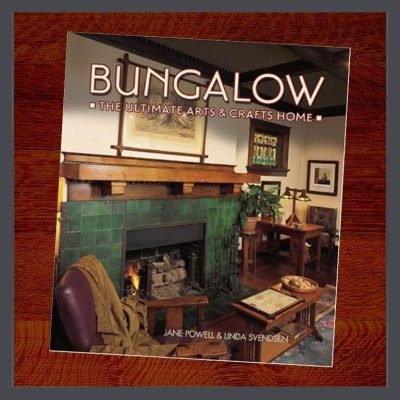 1. Educate yourself on the history & design of your house. Even when hiring a pro, the more you know, the better your project will turn out. I always suggest Jane Powell’s books on bungalows because she’s done all the hard research & the photo’s are beautiful! A good place to start is BUNGALOW: The Ultimate Arts & Crafts Home. If this one merely whets your appitite, there are 5 more on various bungalow topics, each one more informative & fun than the last.2. Familiarize yourself with the 10 points listed in the Introduction to the Standards.3. As much as possible, have a clear idea of what you want to accomplish with your changes- reconstruct its features to return it to its original charm & character, add living space, increase its livability. Have a clean-ly stated purpose.4. Check your state preservation trust or other preservation websites for their lists of architects. I’ll be doing profiles of architects, but I certainly won’t be covering all of them! What I will do is the cover the most important points about each architect so that you can have a better idea of what you should be looking for in hiring one to design changes to your bungalow.5. Study their website & reviews, looking for training & credentials, awards, images of their work & happy clients.
1. Educate yourself on the history & design of your house. Even when hiring a pro, the more you know, the better your project will turn out. I always suggest Jane Powell’s books on bungalows because she’s done all the hard research & the photo’s are beautiful! A good place to start is BUNGALOW: The Ultimate Arts & Crafts Home. If this one merely whets your appitite, there are 5 more on various bungalow topics, each one more informative & fun than the last.2. Familiarize yourself with the 10 points listed in the Introduction to the Standards.3. As much as possible, have a clear idea of what you want to accomplish with your changes- reconstruct its features to return it to its original charm & character, add living space, increase its livability. Have a clean-ly stated purpose.4. Check your state preservation trust or other preservation websites for their lists of architects. I’ll be doing profiles of architects, but I certainly won’t be covering all of them! What I will do is the cover the most important points about each architect so that you can have a better idea of what you should be looking for in hiring one to design changes to your bungalow.5. Study their website & reviews, looking for training & credentials, awards, images of their work & happy clients.
Decide on a budget, the more itemized the better.6. Select 3 to interview. Some charge for interviews, so ask if there is a fee.
7. Be sure ask about & meet the person who would directly manage your project. Inquire as to their credentials & qualifications & ask about their availability. Ask for references on that particular architect on similar projects and check them. Drive around & look at their work.
8. Ensure that you understand everything in their proposal.
9. Feel confident with the firm & the architect before proceeding.
Have a great project!
 STAY IN THE BUNGALOW KNOW!!!
STAY IN THE BUNGALOW KNOW!!!
Sign up for our newsletter & receive our FREE E-book, 7 VITAL Things to Do Before You Hire a Contractor.
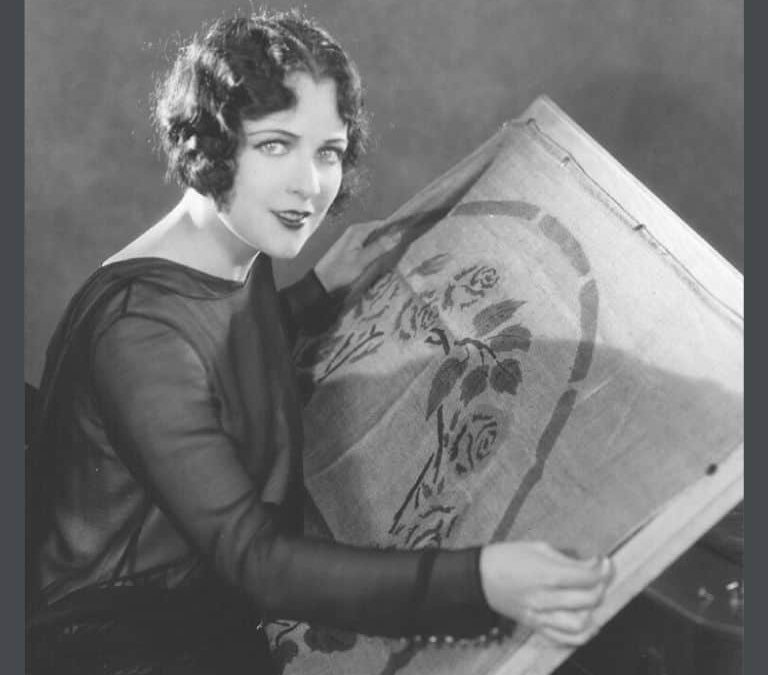
by bungalow101 | Jun 15, 2022 | Doors & windows, Other areas
 The subject of bungalow window coverings & the resources where they can be found is much debated, but is actually pretty simple. Nobody wants to cover their beautiful window moldings, but blocking the sun is generally desired & blocking passing eyeballs is highly recommended!
The subject of bungalow window coverings & the resources where they can be found is much debated, but is actually pretty simple. Nobody wants to cover their beautiful window moldings, but blocking the sun is generally desired & blocking passing eyeballs is highly recommended!
Jane Powell used to joke that the Revival has lo-o-ong out-lasted the original Arts & Crafts Movement. Well, yeah, but it has brought us some amazing craftspeople & I must admit that my favorites are those working in textiles. In the right hands, a bit of fabric, a snip of thread or a bit of paint can create astonishing window art.
Textile art is something that you can learn to do yourself. When I was a hippy, way back in the early 70’s, I loved to embroider, learning from books & the artistry of my friends. You can tote your work around with you & no one ever seemed to mind that I’d pick it up mid-conversation. (Of course, we were pretty mellow those days.)
I have included here textile artists, all well-known for their work, who offer window treatments. They also offer complimentary items such as pillows, table runners & upholstery covers. Of course it is not mandatory to have adornment on your curtains because the beautiful fabric & even the lovely hem work will enhance any room in which you use them.
Several of these artists offer stencil & embroidery patterns, & I’ll be including links to others who deal in only those goods, so if you want to create your own embellishment, you can do so. I would love to see what you make, so please send me images of your homes with your lovely new blinds!!
Hardware is also a tricky issue so I have included harware sources below. I’m a bit of a hardware addict, & when I needed to replace some of the hardware in the Hare House, I formed a friendship with my hardware specialist & 20 years & 3 houses years later, we get together when she visits her sister in St. Pete. We can spend hours on the phone talking hardware & I have been nagging her to write a book on doorknobs.
HERE ARE YOUR BUNGALOW WINDOW COVERINGS RESOURCES!
 Ann Wallace For Prairie Textiles/melton Workroom
Ann Wallace For Prairie Textiles/melton Workroom
Ann carries a full line of custom made window treatments-curtains, Roman shades, roller shades- in a variety of appropriate fabrics. She offers either stenciling or embroidery & will help you to choose the best combinations. She has a lovely collection of embroidery choices to best complement your home.
If you want to stencil your own designs, she has the stencils, brushes & the paints. I have always lovely thistles- even once named a kitty Thistle! And, she has all the hardware that you would need to install your wonderful new window treatments. She’ll also make you pillows, runners & bedspreads to match or complement!
 Arts & Crafts Period Textiles
Arts & Crafts Period Textiles
From The Workshop Of Diane Ayers
In addition to her custom, hand-made wares, Diane features antique textiles also which combine beautifully with newly made pieces & can serve as great inspiration. She also carries antique books about the Arts & Crafts period, most on the topic of design.
Diane’s website takes you step-by-step through planning your order, being with lifestyle requirements. She continues with fabric descriptions & choices, embellishment offerings & discusses the need for lining. You can also purchase beautiful & appropriate fabric from her to make your own curtains.
She has some great information & clear illustrations to demonstrate mounting choices & shows mounting hardware in her catalogue.
 From The Studio Of Natalie Richards
From The Studio Of Natalie Richards
Natalie is a Roycroft Renaissance Artisan. This designation is awarded only to those who demonstrate high quality hand-craftsmanship, excellence in design, continuing artistic growth & originality of expression.
On her site, she provides an explanation of the different curtain types/choices that exist. She also describes many fabric types. It’s a good, basic lesson.
Natalie offers curtains in a great assortment of fabrics with a number of finishes. She also has embroidered & stenciled pillows & embroidered table runners as well as kits for these items. In addition, you can purchase fabric from her as well as embroidery supplies.
Morris & Co.
This British company recreates William Morris’ designs in beautiful fabric, wallpaper & paint, in lush colors to complement a more formal home. When I chose fabric for the Hare house, I was not aware of this resource. I liked the fabric I chose, but I would have been much happier with the patterns I saw in my books about Morris.
Unfortunately, their products cannot be purchased online, so you’ll need to use their search feature to locate a retailer near you. Howver, what could be bad about visiting these lush colors & patterns?
Morris’ designs represent the philosophical & aesthetic inspiration for your bungalow. Even if they are not appropriate in your more casual, American Craftsman home, they are an important part of its history with their interpretations being expressed in every feature.
 Cooper Lace
Cooper Lace
Cooper Lace offers 100% cotton, Scottish-woven sheers & sidelights in a variety of Arts & Crafts patterns. My favorite, of course, because it enhanced the windows of the Hare House, is their Voysey, The Stag, but there are several others which would complement your bungalow, giving you varying degrees of light penetration & privacy. The image is of the Ginkgo Leaf, a revered & oft-repeated image in the Movement.
Alameda Shade Shop
Pull-down blinds are what you want to have in your bedroom. They can be used alone, with a valence, behind lace or other open-weave fabrics.
While there are a great number of Victorians on their site, they do offer a plain hem with a ring pull, in cotton. (Just waiting for you to add your own flair with a custom, stenciled design!) Their room darkening, fire retardant, washable blind is offered in 3 neutral tones. Each blind is custom made to your specifications. They even offer laminations, using your own fabric and which they apply to their blackout fabrics.
If you are in the San Francisco Bay area, they can offer you more choices in their gallery.
 Zwick Window Shade Company
Zwick Window Shade Company
Founded in 1930, Zwick is in its third generation as a family business, manufacturing handmade custom shades in their Chicago workshop.
Each shade is made to your exact specifications. They’ll re-cycle your old rollers to use them for your new shades & give you a discount! From their Build Your Custom Window Shade feature, you can choose the mundane details such as measurements & also the more entertaining ones such as fabric, trim & pulls. And, they include mounting hardware.
BUNGALOW WINDOWS-STENCILS
There are many books available that provide stencil patterns & ideas for patterns should you choose to create your own, as well as vendors that feature ready-cut ones.
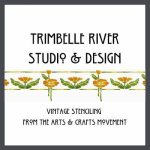 Trimbelle River Studio & Design
Trimbelle River Studio & Design
Vintage stenciling from the Arts & Crafts Movement
Trimbelle River is a complete resource for stencils. They provide a large & beautiful variety of designs- floral, geometric, very large, as well as supplies such as brushes.
These wonderful folks have partnered with Northeast Contemporary Services, Inc. a group of adults with intellectual and developmental disabilities & promote their stenciled items. You can sign up to be notified for their sales via Trimbelle River’s website.
BUNGALOW WINDOW COVERINGS RESOURCES- HARDWARE
 Rejuvenation Hardware
Rejuvenation Hardware
Rejuvenation offers single mounting sets & also rings in several finishes. They also have metal tiebacks that you can mount to hold back your curtains. These are handy because you’re not going to want to use ornate fabric tie-backs on the simple window dressings.
 Historic Houseparts
Historic Houseparts
This vendor offers- well-everything! In addition to my vintage appliance addiction, I am mesmerized by old hardware & promise you will get lost in this site. That’s why I sent you directly to the curtain hardware section. I’m trying to help.
They carry single & double mounts, rods & a beautiful assortment of glass tie-backs.
I have many textile images on my Pinterest page so you can see the work of these very skillful fabric artists & others.
 STAY IN THE BUNGALOW KNOW!!!
STAY IN THE BUNGALOW KNOW!!!
Sign up for our newsletter & receive our FREE E-book, 7 VITAL Things to Do Before You Hire a Contractor.
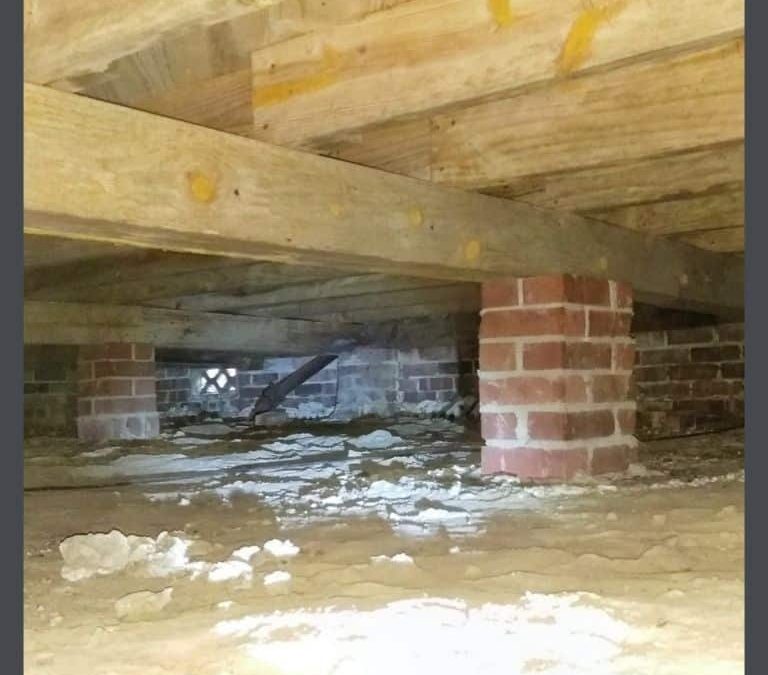
by bungalow101 | Jun 14, 2022 | Foundations & Masonry
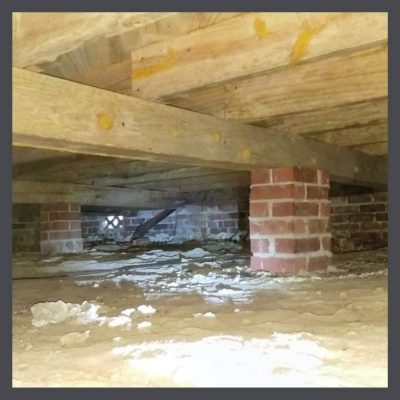 Your bungalow’s foundation was the first thing to be built give or take, 100 years ago. It is still of primary importance. It bears the weight of your house & all its contents- your cast iron bathtub, your refrigerator, your bookshelf. If you live in a cold climate, it also bears the weight of winter snow, which weighs in at about 15 pounds per cubic foot.
Your bungalow’s foundation was the first thing to be built give or take, 100 years ago. It is still of primary importance. It bears the weight of your house & all its contents- your cast iron bathtub, your refrigerator, your bookshelf. If you live in a cold climate, it also bears the weight of winter snow, which weighs in at about 15 pounds per cubic foot.
In this article I am going to address what can adversely affect your foundation. I’m not enthusiastic about warning people about dangers without giving them solutions so I’m including what you can do to ensure that yours stays strong & level.
The ground beneath us moves often, shrinking during dryer times & expanding during wet ones, & does not move uniformly, causing damage to the supporting piers of your bungalow’s foundation.
STEPS TO TAKE TO PROTECT YOUR BUNGALOW’S FOUNDATION
1. Plant trees well away from your exterior walls. The Arbor Day Foundation recommends that you plant a medium (30’- 40’) tree at least 15’ away from a wall. A taller tree. Such as an oak, needs to be at least 20’. Most tree roots spread 2-3 times the radius of the canopy, & often reach out 5 times the radius of the tree canopy & in dry conditions, they can spread even further. As they grow, they disrupt the soil.
Some trees have more invasive roots, some that are water-seeking. Replacing a root-infested main drain pipe (which carries all the water from your house to the city connection or to your septic tank) typically requires excavation, which makes a mess in your yard & can be hideously expensive. Trees with invasive roots may need a minimum distance of 25 to 50’. Slow-growing trees generally have less destructive roots than those that grow quickly. Before you plant a tree, find out about how its root system will behave.
2. Take a deep breath!
Your foundation needs to breath. If water gets underneath your house, it must be able to dry out. A non-vented crawl-space is dangerous to your foundation & your floors. Read this article on how you can help it get some much needed air.
3. Remove dead trees, stumps & root systems from areas near the house. They attract termites & your bungalow, depending on wood beams to support it doesn’t need to be weakened by the gnawing of termites.
 4. Install gutters. They channel rainwater from your roof to downspouts & keep your beds from getting washed out. But here’s the trick, you need to install gutter extenders or your gutter will pour all that water right onto your foundation. You need at least 8’ extenders to take that water away. This is most important if you live in a wet area, like I do in Florida, or during the rainy season even in a dryer climate. You can move the ends of the extenders around so that no one area is getting too much water, or, you can choose plants far from your house that would appreciate the extra soaking. I attached several together & put them on my bananas. My neighbors stopped answering their doors when I’d show up with yet more banana bread! You can get extenders at any big box hardware store, or even on Amazon. They are cheap, very easy to install & remove & take up little space in storage. Honest, you need them.
4. Install gutters. They channel rainwater from your roof to downspouts & keep your beds from getting washed out. But here’s the trick, you need to install gutter extenders or your gutter will pour all that water right onto your foundation. You need at least 8’ extenders to take that water away. This is most important if you live in a wet area, like I do in Florida, or during the rainy season even in a dryer climate. You can move the ends of the extenders around so that no one area is getting too much water, or, you can choose plants far from your house that would appreciate the extra soaking. I attached several together & put them on my bananas. My neighbors stopped answering their doors when I’d show up with yet more banana bread! You can get extenders at any big box hardware store, or even on Amazon. They are cheap, very easy to install & remove & take up little space in storage. Honest, you need them.
5. Be alert for leaks. If you suddenly find yourself with an unusually high water bill one month, get suspicious. Leakage can occur in any pipes, your water heater, your ice maker in your refrigerator- a biggy. In my 45 years in the wood flooring business, this was our most common repair.
6. Drainage lines can leak & create problems with you bungalow’s foundation too. We owned a house in which it was discovered that the shower was not hooked up to the sewage system. All the water drained under the house! We’d had the house “inspected” but this was not noticed & had been going on for decades.
Do not overlook the draining of your HVAC’s condensate lines. Under the indoor unit of your HVAC system, there sits a large metal pan. When you run your air conditioner, water collected from the air in the form of condensation will drip out of the unit & flow into the drain pan. From the collection pan, it flows into the drain line & then through a pipe & out your bungalow. You need to make sure that the drain line is not clogged or the pan will overflow, & you need to have that pipe long enough so that the water is not running out close to your house.
7. How is the grading around your house? Does water run away from or toward the foundation? Hopefully this was included in your inspection, but it can be overlooked. Notice where the water runs in a heavy rain.
8. If you find that you are having problems with water sitting under your bungalow, & you determine that your grading is tipped the wrong way, you can have French drains installed to move the water away from your bungalow’s foundation.
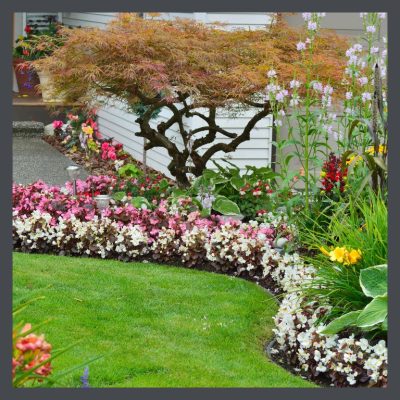 9. When you are doing your hardscaping or landscaping keep in mind the idea that you don’t want to build up your beds so that they are higher than the ground around your house, especially if you have raised borders that will trap rain or irrigation. You don’t want to be building little ponds around your 100 year old masonry piers! If you have raised borders, monitor your irrigation & use gutter extenders to keep heavy rain out of them.
9. When you are doing your hardscaping or landscaping keep in mind the idea that you don’t want to build up your beds so that they are higher than the ground around your house, especially if you have raised borders that will trap rain or irrigation. You don’t want to be building little ponds around your 100 year old masonry piers! If you have raised borders, monitor your irrigation & use gutter extenders to keep heavy rain out of them.
10. Let’s talk about your irrigation system. My husband has been called to inspect homes which have developed cupped (wood) floors & found that the irrigation system was hitting the house. Even if it’s not directly hitting it, your sprinkler heads need to be pointed away from your bungalow’s foundation. It’s a good idea to inspect the system routinely to see if it has sprung any leaks that might be hitting your house or causing water to flow under the house.
11. Keep your plants away from your house. You need to be able to inspect your piers & peer underneath your house to see what’s going on every once in a while. (I never said home ownership is for sissies.)
 12. Protect your bungalow’s foundation from termite damage. I’m going to toss you over to a Bora-Care video to tell you about the product. Then I’d like for you to watch a video on a more toxic product Sentricon.
12. Protect your bungalow’s foundation from termite damage. I’m going to toss you over to a Bora-Care video to tell you about the product. Then I’d like for you to watch a video on a more toxic product Sentricon.
I use both. I had the attic & crawlspace of my bungalow sprayed with Bora-Care & then I installed Sentricon at the perimeter. I don’t know why the Sentricon video presents it as an either/or situation. They each have their place your termite arsenal.
I was lucky to have discovered a wonderful home inspector whom I could call when I had things going on with my house that looked scary. He figured out why my bedroom wall was cracking (water under the house which is how I learned about gutter extenders) & he successfully tracked a leak missed by a bunch of leak detection guys at my friend’s house.
When you own a house & especially when you own a 100 year old bungalow, you need someone who knows more than you do that you can trust. A good inspector is worth her weight in gold before you purchase & as your home changes through the years.
TIP: LEARN MORE ABOUT FOUNDATIONS FROM THE GREAT VIDEOS HERE.
 STAY IN THE BUNGALOW KNOW!!!
STAY IN THE BUNGALOW KNOW!!!
Sign up for our newsletter & receive our FREE E-book, 7 VITAL Things to Do Before You Hire a Contractor.

by bungalow101 | Jun 13, 2022 | Landscaping
 Using native landscaping for your bungalow is eco-friendly, easier care & a beautiful complement to your house of natural materials.
Using native landscaping for your bungalow is eco-friendly, easier care & a beautiful complement to your house of natural materials.
“Everything made by man’s hands has a form, which must be either beautiful or ugly; beautiful if it is in accord with Nature, & helps her; ugly if it is discordant with nature.” -William Morris, considered to be the founder of the Arts & Crafts Movement.
The Movement was a reaction to the Industrial Revolution which had generated new opportunities & economic growth, but also introduced pollution on a scale not yet experienced on our planet. As well, the increased production of materials demanded that we utilize our natural resources at an unprecedented pace.
Our environment is under even greater stress today. More & more species are becoming extinct. The Monarch butterfly was recently placed on the endangered list!
So how can we plant gardens to be, “beautiful if it is in accord with Nature, and helps her.” How can we be in accord with our natural world? By considering native landscaping for your bungalow.
WHY USE NATIVE LANDSCAPING FOR YOUR BUNGALOW?
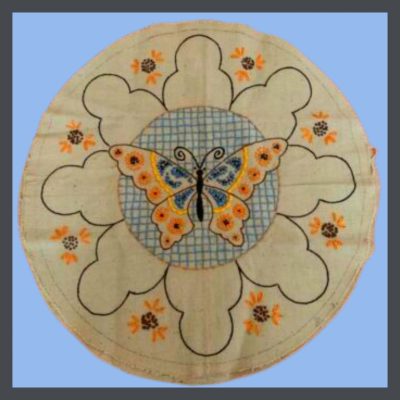 The United States National Arboretum defines a native plant as “one that occurs naturally in a particular region, ecosystem, or habitat without direct or indirect human intervention.” And, how are they beneficial to our natural world?
The United States National Arboretum defines a native plant as “one that occurs naturally in a particular region, ecosystem, or habitat without direct or indirect human intervention.” And, how are they beneficial to our natural world?
The California Native Plant Society states, “These plants have coevolved with animals, fungi and microbes, to form a complex network of relationships. They are the foundation of our native ecosystems, or natural communities.”
This coevolution is the key. Evolution, in biology, is defined as the change in the characteristics of a species over several generations & may result in changes which give the individual an advantage in survival which they can then pass on to their progeny. Coevolution occurs when two species, or groups of species, evolve alongside each other, adapting to changes in the other, giving one another an advantage in survival. These changes could be caused by any source- climate, air & water quality, natural disasters such as fire, pathogens affecting any part of the group, etc. So here we have this nice little group of plants, animals, (including insects) fungi & microbes all working in harmony for the mutual survival of all, making adjustments every generation as together they fine tune their abilities to survive & multiply. It’s the ultimate in cooperation!
A prime example of this is the relationship between flowering plants & insects & birds that pollinate them. The flowering plants have developed adaptations that allow them to attract pollinators, & there is evidence that some flowering plants sweeten their nectar when they perceive the buzz of a bee. The insects and birds have also developed specialized adaptations for extracting nectar & pollen from the plants.
Flowers & their flitting pollinators were a common theme in the textiles & pottery of the Arts & Crafts Movement- bees, butterflies, birds. Life & its creations were considered precious in the Movement & the natural world with its beauty & vitality were exhaulted in their art.
IN THE FOREST, THE ULTIMATE NATIVE GARDEN
Suzanne Simard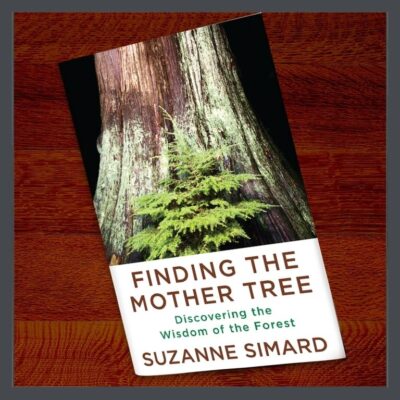 a descendant of loggers, now a professor of forest ecology at the University of British Columbia, is one of the first women in the industry & has made some monumental discoveries about the wisdom of trees. In an interview on NPR she states, “Keep in mind that all trees and all plants — except for a very small handful of plant families — have obligate relationships with these fungi. That means that they need them in order to survive and grow and produce cones and have fitness — in other words, to carry their genes to the next generations. And the fungi are dependent on the plant or the trees … because they don’t have leaves themselves [for photosynthesis]. And so they enter into this symbiosis in that they live together in the root, and they exchange these essential resources: carbohydrates from the plant for nutrients from the fungus, in this two-way exchange which is very tight, almost like a market exchange.
a descendant of loggers, now a professor of forest ecology at the University of British Columbia, is one of the first women in the industry & has made some monumental discoveries about the wisdom of trees. In an interview on NPR she states, “Keep in mind that all trees and all plants — except for a very small handful of plant families — have obligate relationships with these fungi. That means that they need them in order to survive and grow and produce cones and have fitness — in other words, to carry their genes to the next generations. And the fungi are dependent on the plant or the trees … because they don’t have leaves themselves [for photosynthesis]. And so they enter into this symbiosis in that they live together in the root, and they exchange these essential resources: carbohydrates from the plant for nutrients from the fungus, in this two-way exchange which is very tight, almost like a market exchange.
If you give me five bucks, I’ll give you five bucks back. It’s very, very tightly regulated between those two partners in the symbiosis. But, yes, all trees and all plants in all of our forests around the world are dependent on this relationship.”
Now look at this over a span of millions of years. Generation after generation of trees are assisted by beneficial fungi which, in turn, feed on their fallen sisters. Every generation their abilities are expanded & their bonds strengthened.
PLEASE CONSIDER NATIVE LANDSCAPING FOR YOUR BUNGALOW
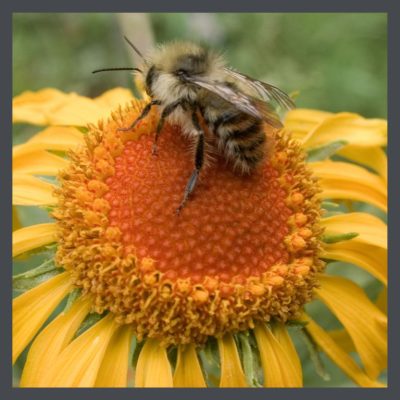 It is plain to see that life supports life. Darwin’s theory of survival of the fittest missed the important point that the fittest are the most cooperative. Cooperation is a natural activity, though we see far too many examples in which it is lacking. My grandmother was a farmer’s daughter & a rosarian, but foremost, she was a teacher. In turn I learned about trees & gardens from my mother. My brother is a Master Gardener. Gardening with your children & grandchildren provides an opportunity to teach them about living in cooperation with their fellows & with our Earth.
It is plain to see that life supports life. Darwin’s theory of survival of the fittest missed the important point that the fittest are the most cooperative. Cooperation is a natural activity, though we see far too many examples in which it is lacking. My grandmother was a farmer’s daughter & a rosarian, but foremost, she was a teacher. In turn I learned about trees & gardens from my mother. My brother is a Master Gardener. Gardening with your children & grandchildren provides an opportunity to teach them about living in cooperation with their fellows & with our Earth.
As a gardener, you can contribute to this circle of life by planting natives. Your climate- temperature, rainfall, seasonal changes- is already in place for it. The make-up of your soil – clay, sandy, silty, peaty, chalky or loamy- is already there. The microbes that were there 100 years ago which developed to assist the indigenous plants are disturbed but you can coax them back to health by planting the species that were at home in your area for hundreds of years, themselves evolving to support the survival of the native microbes.
Planting species indigenous to your area, utilizes all the environmental conditions to their greatest effect because they evolved under these conditions. Their pollinators will return. Your plants will like ‘em & they will thrive with little fuss from you!
Please visit Wild Ones because they can help you get started. These wonderful folks provide resources for purchasing native plants, native garden plans, webinars- pretty much anything that you might need to get started with your new adventure in native landscaping for your bungalow. You can also call your local County Extension Service for advice & if you need help in figuring out which plants would be most attractive with your color scheme, this article on color basics will help.
TIP: Learn more about the Arts & Crafts Movement HERE!
 STAY IN THE BUNGALOW KNOW!!!
STAY IN THE BUNGALOW KNOW!!!
Sign up for our newsletter & receive our FREE E-book, 7 VITAL Things to Do Before You Hire a Contractor.
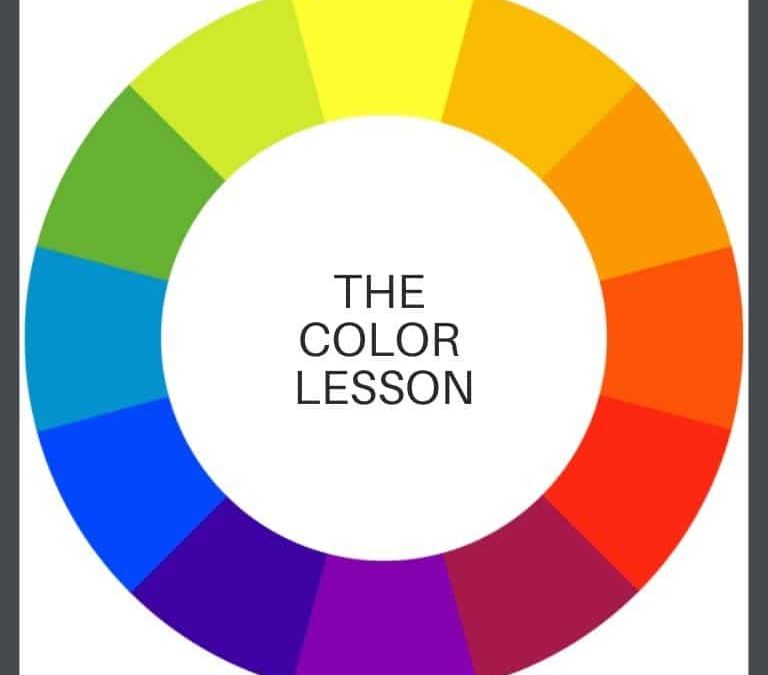
by bungalow101 | May 25, 2022 | Paint
THE COLOR LESSON
 This is a lesson in choosing the right bungalow paint colors, which can be a huge challenge. Most articles give you a few examples, & the paint manufactureres provide pitifully few Arts & Crafts combinations, but they don’t actually teach you anything about the design history of bungalows or about the use of color to best enhance your home. If you want to learn the how & the why of color choices, stick around & read my series of articles, & then you’ll be able to figure it out for yourself & have a custom color scheme, based on your favorite colors, that you will love.
This is a lesson in choosing the right bungalow paint colors, which can be a huge challenge. Most articles give you a few examples, & the paint manufactureres provide pitifully few Arts & Crafts combinations, but they don’t actually teach you anything about the design history of bungalows or about the use of color to best enhance your home. If you want to learn the how & the why of color choices, stick around & read my series of articles, & then you’ll be able to figure it out for yourself & have a custom color scheme, based on your favorite colors, that you will love.
Read in the order they are presented. Each one builds upon the ones previous.
I’m going to start the choosing bungalow colors lesson with some basic terms, so basic that some of you may know them, but have patience, gentle readers, some may not. If you run into a term in a definition that you don’t know, look for it on the list. If it’s not there, let me know so that I can add it. In this part, the list is in teaching order, with images, so that the concepts build, one to the next. You can use this as a glossary in the next articles that will cover more complex colors, explain the Arts & Crafts palette & the final one of choosing colors for your own bungalow.
choosing bungalow colors lesson
CHOOSING BUNGALOW COLORS- THE BUILDING BLOCKS LESSON
Color
A quality of an object which is caused due to the light being reflected by this object.
Color wheel
A tool that shows every color in the full range of colors, by gradients.
Hue
A true color with no white, grey or black added.
Primary Colors
The building blocks of color- red, yellow, blue. These colors & are cheerful & great for kids’ toys.
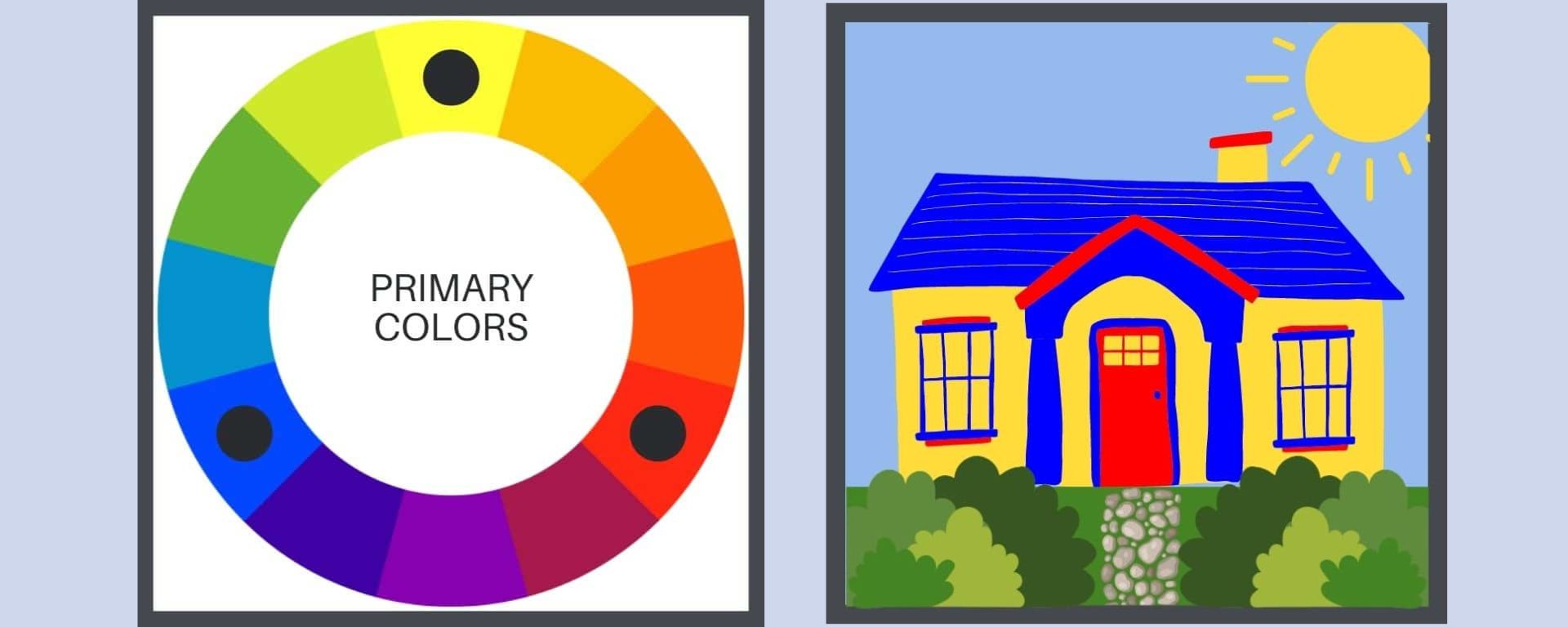
Secondary Colors
Combining 2 primary colors in equal amounts gives you green, orange, violet. I’m actually not sure where this combination would work!

Tertiary Colors
Combining different amounts of the 2 primary colors- gives you red-orange, red-violet, yellow-orange, yellow-green, blue-violet, blue-green. I love this combination of hippy colors!
Remember that at the turn of the last century, they were still using natural materials as tints, so these plastic colors would not have even been possible to create. I’m thinking, let’s keep going so we don’t embarrass this poor house!!!
You can mix tertiary colors to achieve different colors. The closer that different colors are on the color wheel, the more compatible they are, and the more intense the resulting color will be when the colors are mixed. The further they are, the more muted & less intense they will be.

CHOOSING BUNGALOW COLORS-THE COLOR GROUPS LESSON
Cool/Water Colors
Do not include any red. Cool colors do include green, blue, & purple, & variations of those three colors. Blue is the only primary color within the cool spectrum. Greens take on some of the attributes of yellow, & purple takes on some of the attributes of red. As pastels, they can be more subdued than warm colors, but can be more vivid in the jewel tones.
Cool colors tend to be soothing & calming, like a trickling brook.

Warm/Fire Colors
Do not include any blue. Warm colors are of orange, red, yellow, & combinations of these. They tend to make you think of warm things, such as sunlight, fire, heat & friendliness.
Visually, warm colors look as though they come closer, or advance which is why they’re often used to make large rooms feel smaller & cozier. I think that this example may raise my blood pressure a little.
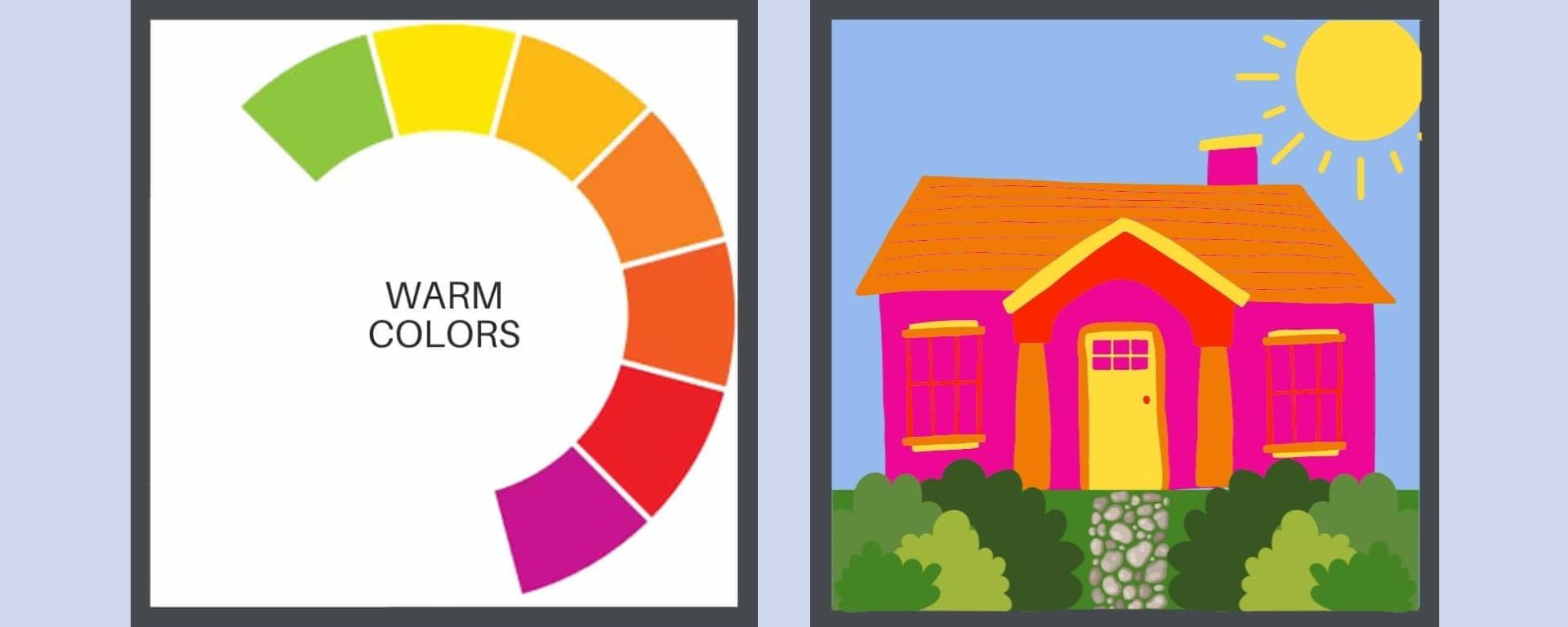
Pastels
These are colors which have white added to them. They can be primary, secondary or tertiary. Happy Easter!
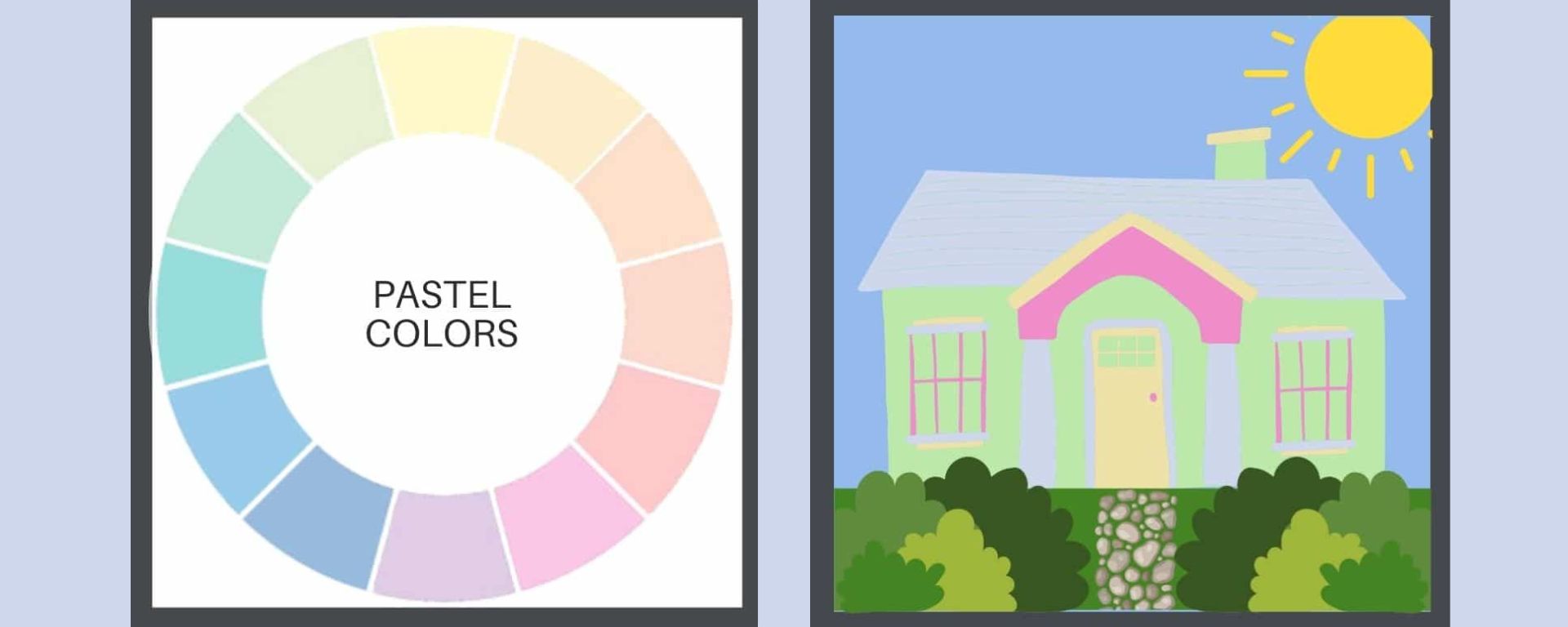
Jewel Tones
Any deep or vivid color suggestive of that of a gemstone; ruby, emerald, sapphire, amethyst, etc. I have actually seen bungalows painted in these wild colors. I live in Florida & I don’t mind them on a Key West style house. .
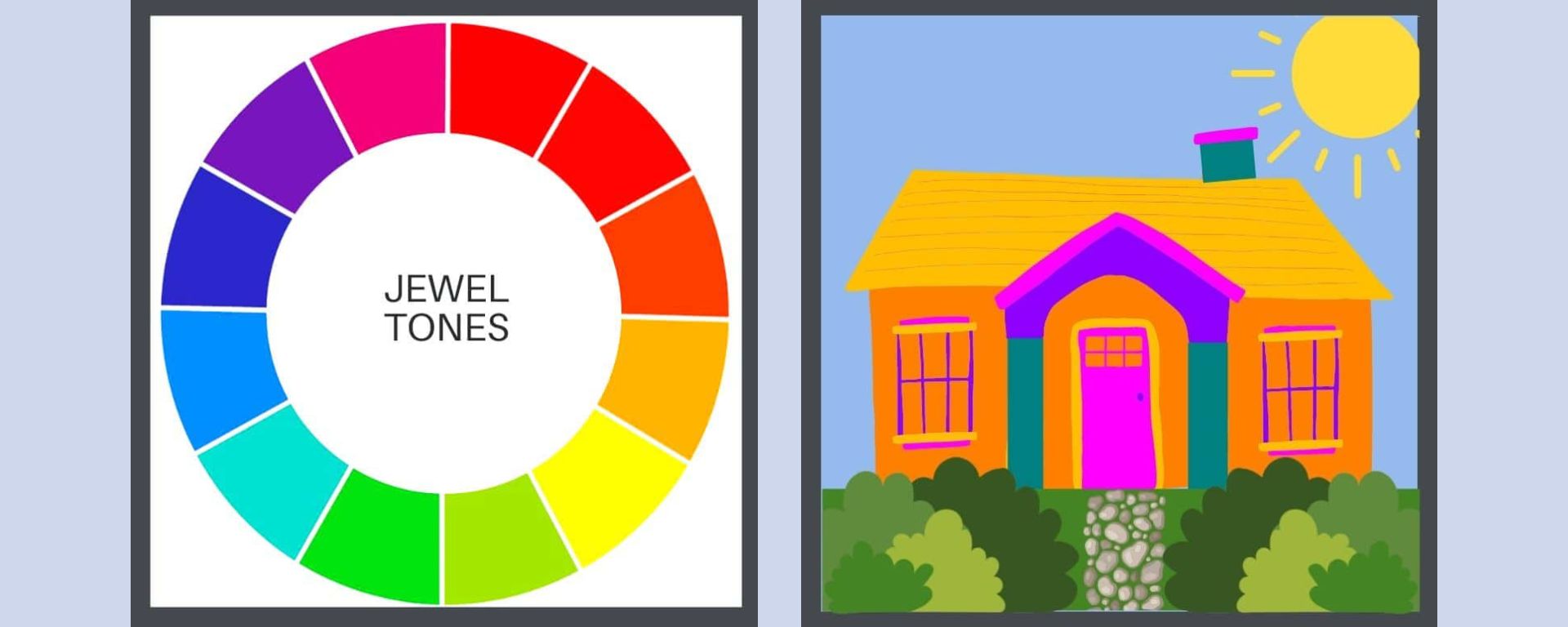
Earth Tones
A group of colors that contain brown, the color of earth or soil. In its larger sense, (& how it will be used here) is colors that are found in nature- soil, grass, trees, berries, flowers, the sky, clouds, the sun. Though we’re not there yet, I find these colors pleasing & the house looks like it’s on friendly terms with the bushes. Well, not these bushes. They’re too bright. Use more subtle plantings, please.
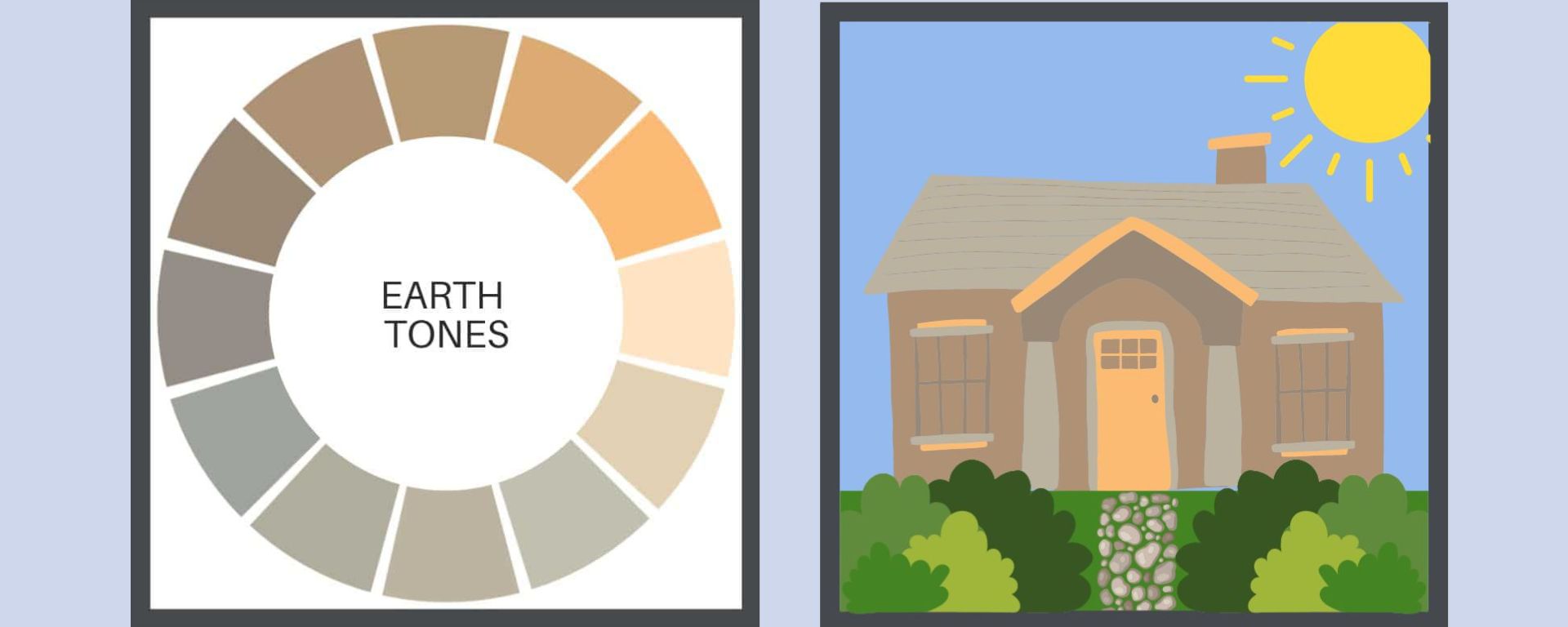
Neutral Colors
Colors that are not found on the color wheel such as gray, beige and brown. Neutral colors are muted shades that appear to lack color but often have underlying hues that change with different lighting. The lighter ones can reflect the colors around them. Though not on the color wheel, they complement primary and secondary colors.
Neutral colors can be complex in tone, as mixing different colors creates unique shades. For example, greige is a mix of light gray and beige, with yellow hues in natural light and gray in fluorescent lighting. (Natural light refers to lighting generated from a natural source like the sun.)
I do not mind an all-neutral palette for a bungalow, but landscaping must be planned to liven it up a little, without overwhelming, & make it look more an extension of nature.

A key issue in color is paint quality.I always recommend Ben Moore because their paints are easy to apply & long lasting. Their colors are well formulated so they are clear & vibrant, they have a great website so that you can search & try colors on a photo of your house, & their customer service is some of the finest in the land.
We are getting closer, but there are still more things to consider before we’re fully submerged in the Arts & Crafts palette.
STEP ON OVER TO PART 2 , COLOR HARMONY, HERE.
 STAY IN THE BUNGALOW KNOW!!!
STAY IN THE BUNGALOW KNOW!!!
Sign up for our newsletter & receive our FREE E-book, 7 VITAL Things to Do Before You Hire a Contractor.

 For BUNGALOW DETAILS: EXTERIOR, as with DETAILS: INTERIOR, I’m going to go chapter by chapter highlighting the contents of this wonderful & informative book, while pointing out the pages that have pictures of my house!
For BUNGALOW DETAILS: EXTERIOR, as with DETAILS: INTERIOR, I’m going to go chapter by chapter highlighting the contents of this wonderful & informative book, while pointing out the pages that have pictures of my house! CHAPTER ONE: WHAT IS A BUNGALOW
CHAPTER ONE: WHAT IS A BUNGALOW Jane loves windows, referring to them as the most important part of the bungalow. She gives us a brief history of window & glass development, with plenty of illustrations in both Linda’s photos & manufacturer pictures. These images also show different muntin (the strip of wood separating & holding panes of glass in a window) configurations.
Jane loves windows, referring to them as the most important part of the bungalow. She gives us a brief history of window & glass development, with plenty of illustrations in both Linda’s photos & manufacturer pictures. These images also show different muntin (the strip of wood separating & holding panes of glass in a window) configurations. On page 190 is my very most favorite image of my house. See the little old lady standing under the arbor with her walker? It’s the ghost of my dear mother. A couple days before the shoot, someone had decided to “trim” the honeysuckle growing on my willow arbor. I was devastated.
On page 190 is my very most favorite image of my house. See the little old lady standing under the arbor with her walker? It’s the ghost of my dear mother. A couple days before the shoot, someone had decided to “trim” the honeysuckle growing on my willow arbor. I was devastated.![]() BUNGALOW KITCHENS
BUNGALOW KITCHENS![]() BUNGALOW BATHROOMS
BUNGALOW BATHROOMS![]() BUNGALOW DETAILS: INTERIOR
BUNGALOW DETAILS: INTERIOR![]() BUNGALOW: THE ULTIMATE ARTS & CRAFTS HOME
BUNGALOW: THE ULTIMATE ARTS & CRAFTS HOME![]() LINOLEUM
LINOLEUM STAY IN THE BUNGALOW KNOW!!!
STAY IN THE BUNGALOW KNOW!!!


 Most people don’t know about preservation architects & how the hiring of one can save you headaches, time & money.
Most people don’t know about preservation architects & how the hiring of one can save you headaches, time & money. Best preservation practices are laid out in the
Best preservation practices are laid out in the  1. Educate yourself on the history & design of your house. Even when hiring a pro, the more you know, the better your project will turn out. I always suggest Jane Powell’s books on bungalows because she’s done all the hard research & the photo’s are beautiful! A good place to start is
1. Educate yourself on the history & design of your house. Even when hiring a pro, the more you know, the better your project will turn out. I always suggest Jane Powell’s books on bungalows because she’s done all the hard research & the photo’s are beautiful! A good place to start is 
 The subject of bungalow window coverings & the resources where they can be found is much debated, but is actually pretty simple. Nobody wants to cover their beautiful window moldings, but blocking the sun is generally desired & blocking passing eyeballs is highly recommended!
The subject of bungalow window coverings & the resources where they can be found is much debated, but is actually pretty simple. Nobody wants to cover their beautiful window moldings, but blocking the sun is generally desired & blocking passing eyeballs is highly recommended! Ann Wallace For Prairie Textiles/melton Workroom
Ann Wallace For Prairie Textiles/melton Workroom Arts & Crafts Period Textiles
Arts & Crafts Period Textiles

 Cooper Lace
Cooper Lace
 Zwick Window Shade Company
Zwick Window Shade Company Trimbelle River Studio & Design
Trimbelle River Studio & Design Rejuvenation Hardware
Rejuvenation Hardware Historic Houseparts
Historic Houseparts
 Your bungalow’s foundation was the first thing to be built give or take, 100 years ago. It is still of primary importance. It bears the weight of your house & all its contents- your cast iron bathtub, your refrigerator, your bookshelf. If you live in a cold climate, it also bears the weight of winter snow, which weighs in at about 15 pounds per cubic foot.
Your bungalow’s foundation was the first thing to be built give or take, 100 years ago. It is still of primary importance. It bears the weight of your house & all its contents- your cast iron bathtub, your refrigerator, your bookshelf. If you live in a cold climate, it also bears the weight of winter snow, which weighs in at about 15 pounds per cubic foot. 4. Install gutters. They channel rainwater from your roof to downspouts & keep your beds from getting washed out. But here’s the trick, you need to install gutter extenders or your gutter will pour all that water right onto your foundation. You need at least 8’ extenders to take that water away. This is most important if you live in a wet area, like I do in Florida, or during the rainy season even in a dryer climate. You can move the ends of the extenders around so that no one area is getting too much water, or, you can choose plants far from your house that would appreciate the extra soaking. I attached several together & put them on my bananas. My neighbors stopped answering their doors when I’d show up with yet more banana bread! You can get extenders at any big box hardware store, or even on Amazon. They are cheap, very easy to install & remove & take up little space in storage. Honest, you need them.
4. Install gutters. They channel rainwater from your roof to downspouts & keep your beds from getting washed out. But here’s the trick, you need to install gutter extenders or your gutter will pour all that water right onto your foundation. You need at least 8’ extenders to take that water away. This is most important if you live in a wet area, like I do in Florida, or during the rainy season even in a dryer climate. You can move the ends of the extenders around so that no one area is getting too much water, or, you can choose plants far from your house that would appreciate the extra soaking. I attached several together & put them on my bananas. My neighbors stopped answering their doors when I’d show up with yet more banana bread! You can get extenders at any big box hardware store, or even on Amazon. They are cheap, very easy to install & remove & take up little space in storage. Honest, you need them. 9. When you are doing your hardscaping or landscaping keep in mind the idea that you don’t want to build up your beds so that they are higher than the ground around your house, especially if you have raised borders that will trap rain or irrigation. You don’t want to be building little ponds around your 100 year old masonry piers! If you have raised borders, monitor your irrigation & use gutter extenders to keep heavy rain out of them.
9. When you are doing your hardscaping or landscaping keep in mind the idea that you don’t want to build up your beds so that they are higher than the ground around your house, especially if you have raised borders that will trap rain or irrigation. You don’t want to be building little ponds around your 100 year old masonry piers! If you have raised borders, monitor your irrigation & use gutter extenders to keep heavy rain out of them. 12. Protect your bungalow’s foundation from termite damage. I’m going to toss you over to a
12. Protect your bungalow’s foundation from termite damage. I’m going to toss you over to a 
 Using native landscaping for your bungalow is eco-friendly, easier care & a beautiful complement to your house of natural materials.
Using native landscaping for your bungalow is eco-friendly, easier care & a beautiful complement to your house of natural materials. The United States National Arboretum defines a native plant as “one that occurs naturally in a particular region, ecosystem, or habitat without direct or indirect human intervention.” And, how are they beneficial to our natural world?
The United States National Arboretum defines a native plant as “one that occurs naturally in a particular region, ecosystem, or habitat without direct or indirect human intervention.” And, how are they beneficial to our natural world?
 It is plain to see that life supports life. Darwin’s theory of survival of the fittest missed the important point that the fittest are the most cooperative. Cooperation is a natural activity, though we see far too many examples in which it is lacking. My grandmother was a farmer’s daughter & a rosarian, but foremost, she was a teacher. In turn I learned about trees & gardens from my mother. My brother is a Master Gardener. Gardening with your children & grandchildren provides an opportunity to teach them about living in cooperation with their fellows & with our Earth.
It is plain to see that life supports life. Darwin’s theory of survival of the fittest missed the important point that the fittest are the most cooperative. Cooperation is a natural activity, though we see far too many examples in which it is lacking. My grandmother was a farmer’s daughter & a rosarian, but foremost, she was a teacher. In turn I learned about trees & gardens from my mother. My brother is a Master Gardener. Gardening with your children & grandchildren provides an opportunity to teach them about living in cooperation with their fellows & with our Earth.
 This is a lesson in choosing the right bungalow paint colors, which can be a huge challenge. Most articles give you a few examples, & the paint manufactureres provide pitifully few Arts & Crafts combinations, but they don’t actually teach you anything about the design history of bungalows or about the use of color to best enhance your home. If you want to learn the how & the why of color choices, stick around & read my series of articles, & then you’ll be able to figure it out for yourself & have a custom color scheme, based on your favorite colors, that you will love.
This is a lesson in choosing the right bungalow paint colors, which can be a huge challenge. Most articles give you a few examples, & the paint manufactureres provide pitifully few Arts & Crafts combinations, but they don’t actually teach you anything about the design history of bungalows or about the use of color to best enhance your home. If you want to learn the how & the why of color choices, stick around & read my series of articles, & then you’ll be able to figure it out for yourself & have a custom color scheme, based on your favorite colors, that you will love.







